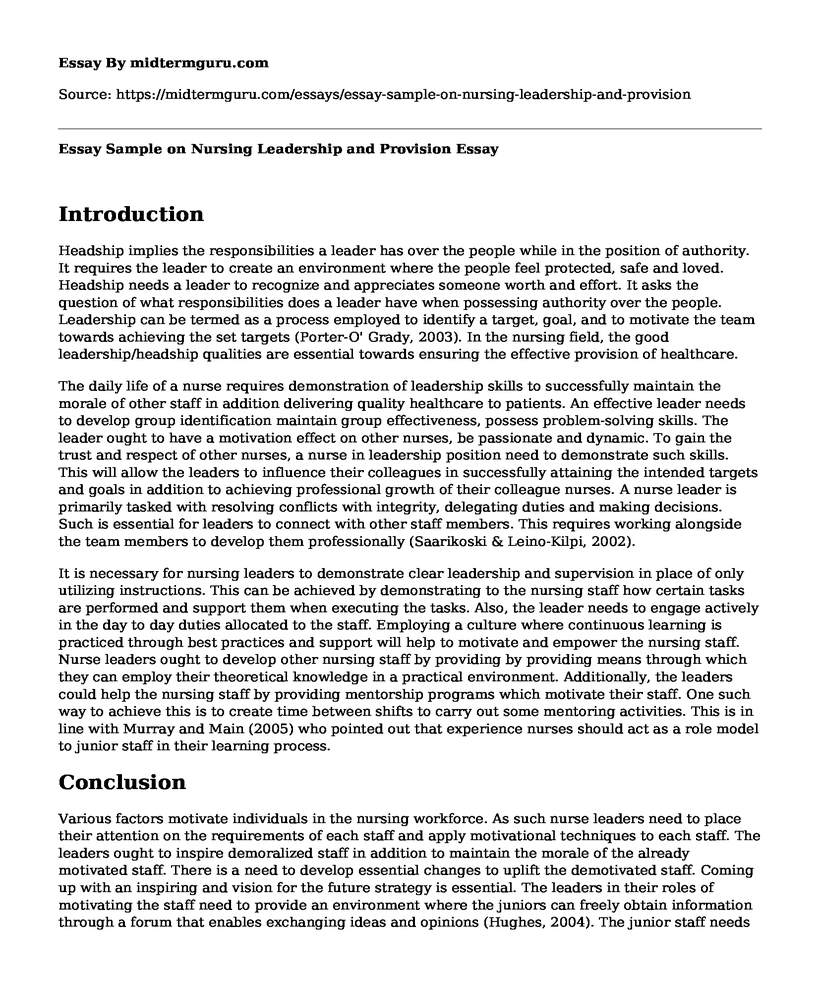Introduction
Headship implies the responsibilities a leader has over the people while in the position of authority. It requires the leader to create an environment where the people feel protected, safe and loved. Headship needs a leader to recognize and appreciates someone worth and effort. It asks the question of what responsibilities does a leader have when possessing authority over the people. Leadership can be termed as a process employed to identify a target, goal, and to motivate the team towards achieving the set targets (Porter-O' Grady, 2003). In the nursing field, the good leadership/headship qualities are essential towards ensuring the effective provision of healthcare.
The daily life of a nurse requires demonstration of leadership skills to successfully maintain the morale of other staff in addition delivering quality healthcare to patients. An effective leader needs to develop group identification maintain group effectiveness, possess problem-solving skills. The leader ought to have a motivation effect on other nurses, be passionate and dynamic. To gain the trust and respect of other nurses, a nurse in leadership position need to demonstrate such skills. This will allow the leaders to influence their colleagues in successfully attaining the intended targets and goals in addition to achieving professional growth of their colleague nurses. A nurse leader is primarily tasked with resolving conflicts with integrity, delegating duties and making decisions. Such is essential for leaders to connect with other staff members. This requires working alongside the team members to develop them professionally (Saarikoski & Leino-Kilpi, 2002).
It is necessary for nursing leaders to demonstrate clear leadership and supervision in place of only utilizing instructions. This can be achieved by demonstrating to the nursing staff how certain tasks are performed and support them when executing the tasks. Also, the leader needs to engage actively in the day to day duties allocated to the staff. Employing a culture where continuous learning is practiced through best practices and support will help to motivate and empower the nursing staff. Nurse leaders ought to develop other nursing staff by providing by providing means through which they can employ their theoretical knowledge in a practical environment. Additionally, the leaders could help the nursing staff by providing mentorship programs which motivate their staff. One such way to achieve this is to create time between shifts to carry out some mentoring activities. This is in line with Murray and Main (2005) who pointed out that experience nurses should act as a role model to junior staff in their learning process.
Conclusion
Various factors motivate individuals in the nursing workforce. As such nurse leaders need to place their attention on the requirements of each staff and apply motivational techniques to each staff. The leaders ought to inspire demoralized staff in addition to maintain the morale of the already motivated staff. There is a need to develop essential changes to uplift the demotivated staff. Coming up with an inspiring and vision for the future strategy is essential. The leaders in their roles of motivating the staff need to provide an environment where the juniors can freely obtain information through a forum that enables exchanging ideas and opinions (Hughes, 2004). The junior staff needs to be provided with the chances to showcase initiative which promotes confidence building while demonstrating competence in the staff skills. These will enable the nurses to achieve their mandate of delivering quality healthcare to professionals effectively.
References
Hughes, S. (2004). The mentoring role of the personal tutor in the 'fitness for practice' curriculum: an all Wales approach. Nurse Education in Practice, 4(4), 271-8.
Murray, C., & Main, A. (2005). Role modelling as a teaching method for student mentors. Nursing Times, 101(26), 30-3.
Porter-O'Grady, T. (2003). A different age for leadership, part 1. Journal of Nursing Administration, 33(2), 105-10.
Saarikoski, M., & Leino-Kilpi, H. (2002). The clinical learning environment and supervision by staff nurses: developing the instrument. International Journal of Nursing Studies, 39(3), 259-67
Cite this page
Essay Sample on Nursing Leadership and Provision. (2022, Oct 04). Retrieved from https://midtermguru.com/essays/essay-sample-on-nursing-leadership-and-provision
If you are the original author of this essay and no longer wish to have it published on the midtermguru.com website, please click below to request its removal:
- Essay on the Veterinarian Law
- Letter to the Senator From the Nurse Asking for Support - Paper Example
- The Effects of Meditation on Sleep Disorders - Research Paper
- Personal Reflection Paper for Nutrition
- Social Work Administration - Essay Sample
- Risk Factors for Birth Defects: Smoking, Alcohol, Drugs, Nutrition - Research Paper
- HIV Prevention Plan Targeted to African American Urban Culture - Essay Sample







